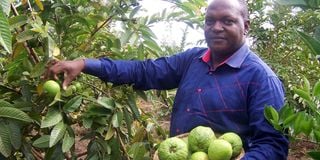Prime
Agronomy tips for planting guava

One must harvest only mature guava. Photo/File
What you need to know:
- The guava is cultivated throughout the lands save hilly arrears. It is mainly grown in the tropics and will tolerate temperatures between 15 and 45 degrees Celsius.
The guava is hardy, aggressive and a perennial tree that has recently become a cultivated crop in Uganda.
Guava is scientifically knows as Psudium guajava and belongs to the family of myrtaceae.
Guava trees are damaged by the citrus flat mite. Guava is an evergreen shrub or small tree grown for its edible fruits.
The guava has a slender trunk with a smooth green to red-brown colour bark.
The trunk can branched at the base and the branches droop low to the ground. The guava fruit is oval in the shape and green to yellow in the colour.
The flesh inside can be white, green, yellow, pink, red in colour and also contains numerous yellow seeds. The tree can grow up to 10 metres high and has a lifetime of 40 years.
Agronomy
Andrew Mubiru, a citrus farmer in Nakasongola, says the guava is considered to be a hardy fruit crop and it is not very choosy for soils. Guava trees grow well in slightly alkaline and poor soils.
“The guava fruits contains vitamin C and it also contains antioxidant factors. It is a good source of roughage and also helps on constipation,” says Mubiru.
Conditions, soils
The guava is cultivated throughout the lands save hilly arrears. It is mainly grown in the tropics and will tolerate temperatures between 15 and 45 degrees Celsius.
The guava is also amenable to a wide range of soils and will grow in both rocky and sandy soils in addition to loam soils. It prefers pH level of 4.5 and 7.
Resistant
“Guavas are more resistant to drought than most tropical fruits and withstand long periods of dry season by ceasing vegetative growth until conditions improve,” says Mubiru who has also planted 10 acres of highbred guavas.
Propagation
Guavas that grown for fresh fruits are vegetatively propagated by layering or budding.
Guava seeds are planted in a nursery bed then transplanted after 30 days. Guava planting is done during the rainy season, March to June is the ideal period to plant the seedlings.
Spacing
The seedlings are usually planted at a distance of five to six metres. The exact spacing is determined by the variety, soil type and availability of irrigation.
The standard spacing is six by six metres with a population of 110 plants per acre. High-density planting causes erect growth of branches making the plant tall, compact and also giving higher yield.
Irrigation
After planting, a farmer must irrigate immediately for the next seven days.
After seven days of consistence irrigation, the farmer may concentrate of applying both organic and inorganic fertiliser.
The irrigation must continue until the plant is firm and has started branching. “You must avoid flood irrigation during flowering because it may lead to flower dropping,” says Mubiru.
Pests and diseases
Like any other fruit, the guava is not resistant to pests and diseases. Some of the pests and diseases include;
Fruit fly
Fruit flies are the most common and serious pests that attack the guava fruit. They lay eggs on the surface of the fruit at the colour break stage.
Upon hatching the maggot enters the fruit and feeds on the soft pulp. When the guava fruit is cut wide open, the maggots are seen in the flesh.
This pest can be controlled by keeping your orchard clean.
Guava shoot borer
It is a serious pest that attacks the plant while in nursery bed. It damages the tender plant thereby affecting its growth.
Bark-eating caterpillar
The infestation of this pest can be identified by the presence of irregular tunnels and patches covered with a silken web which contains excreta and chewed-up wood particles on the branches, stem and main trunk.
Shelter holes may be seen particular at the joints of shoots and branches. The young shoots dry and die away giving sickly looks to the guava.
This can be managed by keeping the orchard clean and healthy to prevent further infestations.
The diseases include guava wilt, fruit rot and leaf spot among others.
Fruit flies
Fruit flies are the most common and serious pests that attack the guava fruit.
They lay eggs on the surface of the fruit at the colour break stage. Upon hatching the maggot enters the fruit and feeds on the soft pulp.




